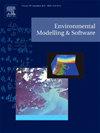How to use general AI for task-specific applications: A case study of monitoring water level trends with river cameras
IF 4.6
2区 环境科学与生态学
Q1 COMPUTER SCIENCE, INTERDISCIPLINARY APPLICATIONS
引用次数: 0
Abstract
Water level variations influence geochemical and hydrological processes within river networks. Water segmentation from river camera images using deep learning supports water level trend monitoring, but domain-specific model accuracies are constrained by limited annotated data. To improve accuracy, this study proposes a framework combining domain-specific models with General AI. The framework uses the Segment Anything Model (SAM) as backbone, with a pre-trained ResUnet model identifying highest-probability water pixels as a prompt to SAM, without any requirement for human intervention or local annotation. Applied to river camera images from Tewkesbury, UK, the framework increased the Intersection over Union (IoU) by over 15 % compared to the single ResUnet. Point prompt was identified as the optimal mode for feeding water-related prior knowledge to SAM. The static observer flooding index derived from segmented masks showed a strong correlation (0.90) with real water level, surpassing the ResUnet's 0.54. Our framework allows for the supplementation of river monitoring networks with camera gauges, providing robust water level trend observations.
如何将通用人工智能用于特定任务应用:用河流摄像机监测水位趋势的案例研究
水位变化影响河网内的地球化学和水文过程。使用深度学习从河流相机图像中分割水支持水位趋势监测,但特定领域的模型精度受到有限的注释数据的限制。为了提高准确性,本研究提出了一个将特定领域模型与通用人工智能相结合的框架。该框架使用分段任意模型(SAM)作为主干,使用预训练的ResUnet模型识别概率最高的水像素作为SAM的提示,不需要任何人为干预或局部注释。将该框架应用于英国图克斯伯里的河流摄像机图像,与单一的ResUnet相比,该框架将Union (IoU)交叉口增加了15%以上。点提示是向SAM输入水相关先验知识的最优模式。由分段掩膜导出的静态观测者洪水指数与实际水位的相关性(0.90)较强,超过了ResUnet的0.54。我们的框架允许用相机测量仪补充河流监测网络,提供可靠的水位趋势观测。
本文章由计算机程序翻译,如有差异,请以英文原文为准。
求助全文
约1分钟内获得全文
求助全文
来源期刊

Environmental Modelling & Software
工程技术-工程:环境
CiteScore
9.30
自引率
8.20%
发文量
241
审稿时长
60 days
期刊介绍:
Environmental Modelling & Software publishes contributions, in the form of research articles, reviews and short communications, on recent advances in environmental modelling and/or software. The aim is to improve our capacity to represent, understand, predict or manage the behaviour of environmental systems at all practical scales, and to communicate those improvements to a wide scientific and professional audience.
 求助内容:
求助内容: 应助结果提醒方式:
应助结果提醒方式:


